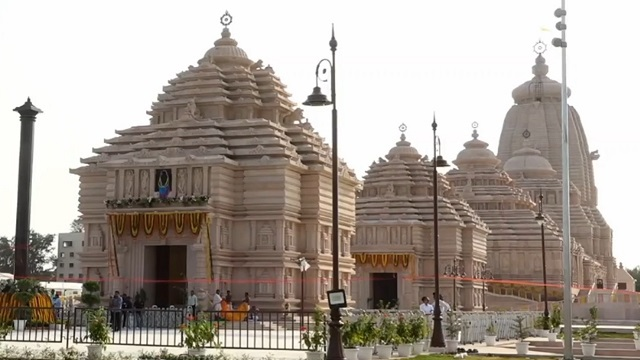
The newly constructed Jagannath Temple has positioned itself as a monument of worship, architectural beauty and a cultural talking point bubbling amid Digha’s coastline in West Bengal. The 12th-century famous Jagannath Temple of Puri, Odisha, has served as a model for this astonishing temple, which is revered as an embodiment of Sikhism and pride for the region and the devotees alike. However, underneath its magnificent aesthetic, this temple is steeped in history, dreams, and a splash of drama.
A Modern Replica of an Ancient Wonder
The grand opening of Jagannath Temple in Digha was celebrated on April 30, 2025. Jagannath Temple will be constructed on a massive area of 24 acres, which was intended to invoke the sacred feeling attached to Puri’s Jagannath Temple in the worshippers hailing from West Bengal and its bordering states. As with the Blockbuster hit Puri Temple, the Jagannath in Digha has also been designed in Kalinga architectural style, which allows it to soar to an astonishing height of 213 feet.
The temple complex has four main parts: Vimana (the deity’s innermost sanctuary), Jagamohan (the hall of the congregation), Nat Mandir (the dance hall danced in by the deities dance), and Bhog Mandap (the hall for offerings). The primary deities are also similar to those in Puri: Lord Jagannath, Lord Balabhadra, Goddess Subhadra, and Goddess Mahalaxmi. A key difference is that while the statues in Puri are made from neem wood and are replaced every twelve to nineteen years during the Nabakalebara sacred ritual, the Digha idols are permanently stone carved.
Turning Dreams Into Reality
This temple stems from an initial concept dating back to 2019, with construction commencing in May 2022 under the West Bengal Housing Infrastructure Development Corporation (WBHIDCO) supervision. With an estimated cost of 250 crores, the goal behind this project was to build a functional place of worship while simultaneously being an attraction for tourists to visit, thus increasing the local economy spiritually.
Controversy and Cultural Sensitivities
Despite its beauty and spiritual significance, the Digha Jagannath Temple has caused quite a controversy, especially with the state of Odisha. The most significant issue arises from the claim of using the title “Jagannath Dham” for the Digha temple, a naming privilege associated with the Puri temple, which is one of the Char Dham of Hinduism.
Odisha’s government and Jagannath Temple authorities in Puri have expressed strong objections. They have raised concerns about the participation of Puri’s traditional servitors in the Digha temple’s consecration ceremony and the use of leftover neem wood from Puri’s Nabakalebara rituals to craft idols for the new temple. Odisha’s Law Minister Prithiviraj Harichandan described these actions as “totally unacceptable” and hurtful to the sentiments of Odia people and Jagannath devotees worldwide.
Attendees of the Digha inauguration, including Servitors from Puri Ramakrishna Dasmohapatra, have been socially ostracised by their peers. Many are concerned that imitating Puri’s rituals and symbols could blend into the Digha landscape, thus removing the divinity or sacred nature of the original shrine. Including the Nilachakra, the metal wheel resting on Puri’s temple, in Digha’s advertising and sightseeing promotional literature is also viewed as a blatant misappropriation.
Advancing Issues
In the region’s debate, concern about the fuel for the economy adds another dimension. A considerable proportion of the pilgrims coming to Puri are from West Bengal. There is a worry that serving temples in Digha might steal away some devotees and tourists, impacting the revenue of Odisha tourism. However, other experts argue that Digha does not have the infrastructure to support tourism like Puri. They say that Digha is lagging far behind in developing tourism infrastructure and should divert efforts to Digha.
An Overview
Standing tall today, the Jagannath Temple in Digha is truly the epitome of faith and finer, judicious artistry in construction. On the one hand, it adds to the number of auspicious places that pilgrims and tourists can travel to; on the other, it also conveys the need to maintain the balance between traditions and innovative interpretations of devotion.
Maintaining its status and beautifully commemorating the worship of the Jagannath are West Bengal’s temples’ most important sights, which, for many, become an essential stopover. For Hindus as well, it generates dialogues on the issue of ethnocentrism, patriotism and the religion’s evolution.
Everyone Should Know the Jagannath Temple Story
Jagannath Temple in Digha is not merely about stones or idols placed within the structure; it is resonant with faith and identity, and within its scope rests the beautifully woven connection of people from different states. It allows a dip into the heritage and sometimes serves as a fresh start to a never-ending spiritual journey.
With time, the temple will slowly manage to draw people toward it. There will undoubtedly be more devotees visiting, and more devotees will be keen to observe the spiritual struggle and the phenomenon of modernity, which is adding to the age-old custom of Jagannath temple veneration in India.
Thinking of visiting? Temple offers a simple approach from Kolkata and adjacent towns, thus perfectly complementing any soulful, cultural, or touristic program in the eastern part of India.
You may read this: Jagannath Temple Digha | Jagannath Dham Digha | Queries and Answers | West Bengal

